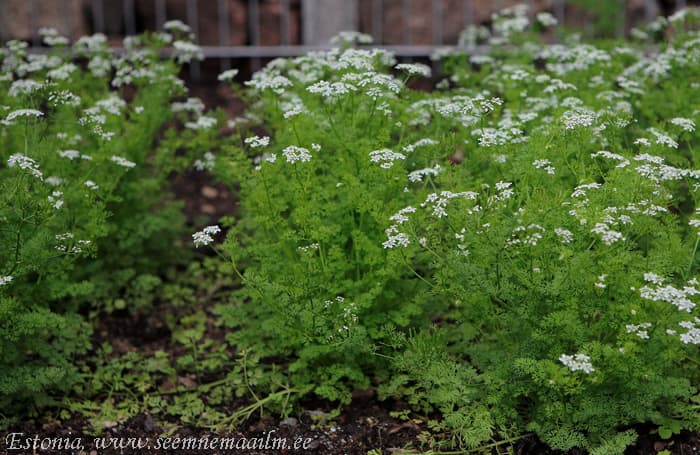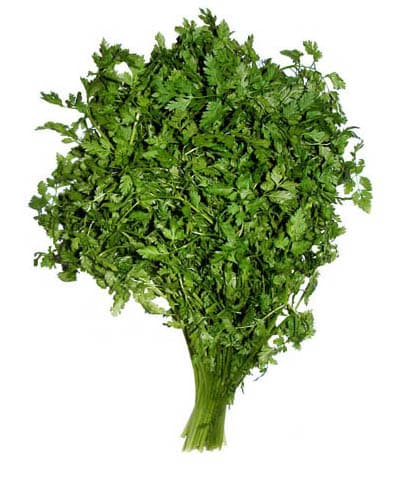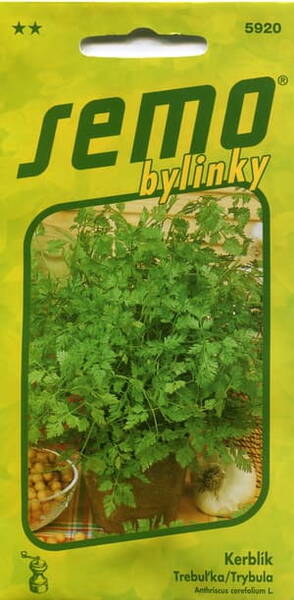Annual spice plant of 30-60 cm in height. Young fresh waved leaves before the bloomy period are used for food. Leaves have a nice anise scent. Due to chervil, your food becomes not just aromatic but also enriched with vitamins C, A, also magnesium and Fe. Suitable for meat, soups, sauce, tones and provokes appetite. Enriched with humus, wet loamy soil, a semi shadow or a sunny place suits the best. Suitable for sowing in summer and autumn. Chervil could be sought or sprouts could be planted among salad. It will protect the salad from blight, earthworms and ants.
1 g contains approximately 400 seeds.
Sensoric quality.
Sweet and aromatic, somewhat intermediate between parsley and anise. On other spices with a similar fragrance. Main constituents The plant contains only minor amounts of essential oil (0.3% in the fresh herb, 0.9% in the seeds); it contains methyl chavicol (estragole) and hendecane (undecane). Origin Probably Southern Europe or the Caucasus region. Chervil became known in the regions north of the Mediterranean by the edict of Charlemagne, Capitulare de villis.
Chervil leaves are harvested before flowering. The yield can be increased by promptly cutting off emerging flower stalks. Plants sown late, in September, overwinter well, forming lush rosettes of leaves in the spring.
Chervil is a delicate spice, typical primarily of refined French cuisine. Because its aroma, reminiscent of anise and parsley, easily evaporates, chervil leaves should be added to hot dishes only at the last stage of cooking, preferably fresh. Chervil, combined with parsley, tarragon, and chives, creates a delicate blend that is especially delicious in omelets. On hot summer days, chervil adds a fresh flavor to cottage cheese spreads and bread and butter. Green salads can be dressed with chervil-infused white wine vinegar. Fresh leaves can be stored for the winter by placing them in the freezer. Chervil contains vitamin C, carotene, rutin, mineral salts, and phytoncides. In medicine, it is used for rashes, glandular inflammation, and as a tonic and digestive aid. In folk medicine, it is used to improve digestion, treat inflammatory respiratory diseases, jaundice, and as a diuretic.
* By the way, if you have an ant infestation in your apartment, place chervil sprigs in the insects' favorite spots, and the scent of the herb will drive them away.
* Tender young leaves are easily digested and absorbed by the body. They can be stored for 2-4 days in water or in the refrigerator at 0 to 4°C.
* Young chervil leaves, which appear in early spring, are tender and pleasant to the taste, containing many nutrients. They are used in the same way as parsley leaves, but preferably without heat treatment (otherwise the aroma and vitamins are lost).

Chervil is not only beautiful and useful, but also a medicinal plant used as a tonic, digestive aid, anti-inflammatory for respiratory diseases and jaundice, and a diuretic.
Chervil is propagated by seeds (small, black, elongated), which retain their germination capacity for about 4 years.
This unpretentious, fast-growing, shade-tolerant, cold-resistant plant can be sown before winter and at intervals throughout the spring and summer (preferably in partial shade).
Any soil is suitable for chervil, but loose, fertile, and sufficiently moist soil is preferable. Seeds are sown to a depth of 0.5 cm; shoots appear in 2-3 weeks. Frequent shoots are thinned out, leaving about 15 cm between plants. With a lack of moisture and strong summer heat, the leaves of chervil quickly become hard, and the plant develops stems-flower stalks. Numerous ripe seeds fall to the ground, giving abundant self-seeding. If you need to collect chervil seeds, the stems are cut when the seeds turn brown and dried in the shade.

Eng.: Garden chervil, cow parsley, french parsley. Bot. syn.: Anthriscus longirostris Bertol., Cerefolium anthriscus L., Cerefolium cerefolium L., Chaerefolium cerefolium L., Chaerophyllum sativum Lam., Scandix cerefolium L.
Chervil sauce.
Grind boiled yolks, mix with raw yolk and rub in half of the butter drop by drop while continuously grinding. Then gradually add vinegar and mustard and the rest of the butter. Add sour cream and finely chopped chervil, salt and pepper to taste. Serve the sauce with boiled meat, eggs, potatoes.
Chervil (young leaves) - 3-4 tbsp., egg (hard-boiled) - 2 pcs., yolk (raw) - 1 pc., vegetable oil - 0.5 cups, vinegar - 1 tbsp., mustard - 1 tsp., sour cream - 1 tbsp.
Chervil oil.
Mix the butter and chervil, put in a narrow long mold, freeze and cut into slices. Serve the finished slices with fish, meat, hot potatoes, boiled or baked vegetables.
Butter - 50 g, chervil (chopped) - 2 tbsp, salt - to taste.
Curd paste with chervil and caraway.
Finely chop the chervil, mix all the ingredients.
Cottage cheese - 100 g, chervil (leaves) - 15 g (1 heaped tbsp), sour cream - 2 tbsp, caraway (ground) - on the tip of a knife, salt - to taste.
Vegetable pancakes with chervil and dandelion.
Peel and wash the vegetables. Wash and dry the chervil. Finely chop the mushrooms, onions and tomatoes. Beat the eggs with spices and salt. Grind dandelion and chervil greens, combine with beaten eggs, chopped mushrooms, onions and tomatoes, mix. Spoon into a frying pan heated with oil and fry on both sides.
Milk - 0.5 cups, chervil - 1 bunch, dandelion leaves - 1 small bunch, tomato - 1 pc., onion - 1 pc., mushrooms (fresh champignons, boletus, etc., that do not require boiling) - 3-4 pcs., egg (raw) - 2 pcs., salt, spices (nutmeg, ground red and white peppers) - to taste.
Chervil puree soup.
Divide the chervil into leaves and stems. Chop, set aside. In a large heavy-bottomed saucepan, melt the butter over medium heat, add the chopped onion and cook, stirring, for about 5 minutes. Add the leek and peeled and diced potatoes to the pan; cook, stirring, for another 5 minutes. Pour the broth over the vegetables. Add the chopped chervil stems to the pan, bring to a boil, reduce the heat and simmer the soup for about 20 minutes (until the potatoes are soft). Season with salt and pepper.
Use a blender to puree the soup. Add the chopped chervil leaves and cooked rice to the pureed soup. Serve immediately, garnished with whole chervil leaves.
Chervil - 1 bunch (about 150 g), potatoes - 1 pc., long-grain rice (boiled) - 50 g, onions - 1 pc., white part of leek (chopped) - 1 pc., butter - 25 g, chicken or vegetable broth - 1 l, salt and ground white pepper - to taste.
Soup with white wine and chervil.
Peel the onion and chop very finely. Melt 1 tbsp. butter in a saucepan and fry the onion in it until transparent. Gradually pour in the broth and wine and cook in a semi-closed container over medium heat. Mix 1 tbsp. butter with flour. Make flour dumplings, put them in the soup, dissolve them, whisking with a whisk, and cook for 5 minutes. Add cream and let the soup boil. Beat the yolk. Remove the soup from the stove, add the yolks, season with salt and pepper. Cut the bread and fry in the remaining butter. Season the soup, add the chervil and sprinkle with croutons just before serving.
Chicken broth - 500 ml, dry white wine - 500 ml, onion - 1 pc., butter - 3 tbsp., flour - 1 tbsp., cream - 250 ml, yolk (raw) - 2 pcs., ground white pepper - 0.5 tsp., salt - 0.5 tsp., toast - 2 pcs., chervil (chopped) - 2 tbsp.
Traditional German chervil soup.
Wash the chervil, remove the stems, chop finely. Wash the green onions, chop finely, fry in butter, then pour in the chicken broth and cream and bring to a boil. Season the soup with salt and pepper, add lemon juice. Reduce heat to low, add chervil and remove from heat. Beat the egg yolks with a fork and pour into the soup. Pour the soup into portions, cut the hard-boiled eggs in half and put in each plate. You can add sour cream and garnish with herbs. Eggs - 4 pcs., chervil - 60 g, green onions - 60 g, butter - 20 g, chicken broth - 400 ml, cream - 250 ml, lemon juice - 5 ml, yolk (raw) - 2 pcs., salt and ground black pepper - to taste.












